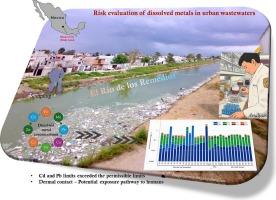Distribution and risk assessment of potentially toxic elements in urban wastewaters of Mexico City
Q1 Environmental Science
Environmental Nanotechnology, Monitoring and Management
Pub Date : 2025-08-23
DOI:10.1016/j.enmm.2025.101097
引用次数: 0
Abstract
The present study assessed the contamination of potentially toxic elements (Cd, Co, Cu, Fe, Mn, Ni, Pb, and Zn) in urban wastewaters from Mexico City, Mexico, using atomic absorption spectroscopy for risk assessment. A total of thirty-two water samples were systematically collected from the River de los Remedios (n = 17), River Tlalnepantla (n = 4), and River San Javier (n = 11) in the northern part of the metropolitan area. Results showed that average elemental concentrations, in mg L-1, followed the order: Mn (0.39) < Pb (0.17) < Fe (0.12) < Cu, Ni, Zn (0.06) < Co, Cd (0.02), reflecting the impact of raw industrial and domestic discharges from the highly urbanized region. Concentrations of Pb and Cd surpassed the legal limits of 0.03 and 0.004 mg L-1, respectively, for wastewater discharge. Statistical analysis of physicochemical parameters and element levels indicated that industrial activities are the main sources of PTEs. The level of pollution was assessed using the heavy metal evaluation index (HEI), contamination factor (CF), and Nemerow pollution index (NPI); results indicated moderate contamination by Pb and overall slight pollution. Human risk assessment calculated for the inhalation and dermal exposure pathways in adults and children indicated that Cd and Pb were the most critical elements that could pose adverse health effects to the local population. Dermal contact was identified as the potential exposure pathway that could pose potential risks to human health. The findings of this study indicate a deteriorating status of the aquatic system in Mexico City, primarily due to the persistent discharge of untreated wastewater, which poses a significant risk to environmental integrity and human health within the urban area.

墨西哥城城市废水中潜在有毒元素的分布及风险评估
本研究评估了墨西哥墨西哥城城市废水中潜在有毒元素(Cd、Co、Cu、Fe、Mn、Ni、Pb和Zn)的污染,采用原子吸收光谱法进行风险评估。系统地从都市区北部的de los Remedios河(n = 17)、Tlalnepantla河(n = 4)和San Javier河(n = 11)共采集了32份水样。结果表明,平均元素浓度(mg L-1)顺序为:Mn (0.39) < Pb (0.17) < Fe (0.12) < Cu、Ni、Zn (0.06) < Co、Cd(0.02),反映了高度城市化地区工业和生活排放的影响。铅和镉的浓度分别超过了0.03和0.004 mg L-1的法定限值。理化参数和元素含量的统计分析表明,工业活动是pte的主要来源。采用重金属评价指数(HEI)、污染因子(CF)和Nemerow污染指数(NPI)对污染程度进行评价;结果表明,铅污染程度中等,总体污染程度较轻。根据成人和儿童的吸入途径和皮肤接触途径计算的人类风险评估表明,Cd和Pb是可能对当地人口健康造成不利影响的最关键元素。皮肤接触被确定为可能对人体健康构成潜在风险的潜在接触途径。这项研究的结果表明,墨西哥城水生系统的状况正在恶化,主要原因是持续排放未经处理的废水,这对城市地区的环境完整性和人类健康构成了重大风险。
本文章由计算机程序翻译,如有差异,请以英文原文为准。
求助全文
约1分钟内获得全文
求助全文
来源期刊

Environmental Nanotechnology, Monitoring and Management
Environmental Science-Water Science and Technology
CiteScore
13.00
自引率
0.00%
发文量
132
审稿时长
48 days
期刊介绍:
Environmental Nanotechnology, Monitoring and Management is a journal devoted to the publication of peer reviewed original research on environmental nanotechnologies, monitoring studies and management for water, soil , waste and human health samples. Critical review articles, short communications and scientific policy briefs are also welcome. The journal will include all environmental matrices except air. Nanomaterials were suggested as efficient cost-effective and environmental friendly alternative to existing treatment materials, from the standpoints of both resource conservation and environmental remediation. The journal aims to receive papers in the field of nanotechnology covering; Developments of new nanosorbents for: •Groundwater, drinking water and wastewater treatment •Remediation of contaminated sites •Assessment of novel nanotechnologies including sustainability and life cycle implications Monitoring and Management papers should cover the fields of: •Novel analytical methods applied to environmental and health samples •Fate and transport of pollutants in the environment •Case studies covering environmental monitoring and public health •Water and soil prevention and legislation •Industrial and hazardous waste- legislation, characterisation, management practices, minimization, treatment and disposal •Environmental management and remediation
 求助内容:
求助内容: 应助结果提醒方式:
应助结果提醒方式:


